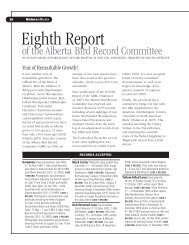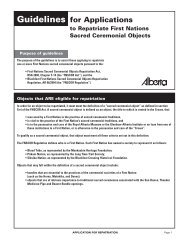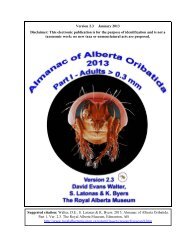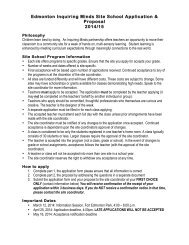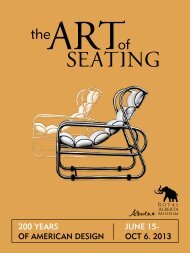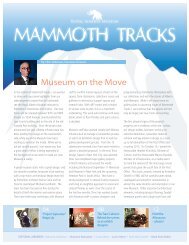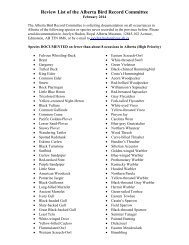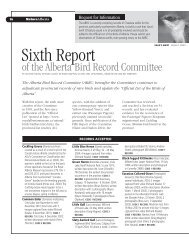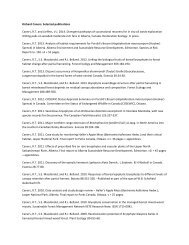Cohort Gamasina - Royal Alberta Museum
Cohort Gamasina - Royal Alberta Museum
Cohort Gamasina - Royal Alberta Museum
- No tags were found...
You also want an ePaper? Increase the reach of your titles
YUMPU automatically turns print PDFs into web optimized ePapers that Google loves.
Almanac of <strong>Alberta</strong> Acari Part II Version 2.02 February 2012 drafton anterior plate or variously elaborated on cheliceral bases; leg coxae fused to body asdistinct plates, epimeral fields, or reduced to folds or internal apodemes (NB - trochanter isfirst free leg segment and may resemble a coxa); gnathosoma with cheliceral bases exposeddorsally, fused into a stylophore (separate from subcapitulum), or integrated withsubcapitulum into a head-like capsule; palps well developed (5 free segments) or variouslyreduced or apparently absent; venter of gnathosoma entire or with articulations, but neverwith a median denticulate groove or with dense field of retrorse spines; 1-2 pairs of ocellimaybe present, but many taxa are blind ........................................ Superorder Acariformes (3)2. Stigmatal openings above legs and usually associated with a distinct peritrematal groove(rarely absent) extending anteriorly or plastron like band; chelicerae usually chelate-dentate,but produced as elongate stylets in some parasites; anterior margin of subcapitulum(hypostome) usually with a pair of horn-like or bidentate corniculi (rarely membranous),never with field of retrorse spines; base of subcapitulum with a median groove with rows of1-many denticles; stalk-like tritosternum with 2-3 processes present at base of median groove................................................................................................................... Order Mesostigmata- Stigmatal openings above coxae III-IV on small plates (Argasidae – soft ticks) or on sieve-platebehind base of legs IV (Ixodidae – hard ticks); gnathosoma visible dorsally and articulatedwith sclerotized scutum (Ixodidae) or mostly hidden under leathery body without sclerotizeddorsal plate (Argasidae); chelicerae with parallel bases and complex distal array of teeth andmembranes and supported by hypostome with ventral field of retrorse spines (reduced insome male hard ticks and non-feeding adult soft ticks); median deutosternal groove andtritosternum absent ................................................................................... Order Ixodida (ticks)3. Functional chelicerae present (often highly modified), palps present, but may be reduced tosmall nubs, and ventral sucker plate absent ............................................................................... 4- Chelicerae absent, palps reduced to a pair of whip-like structures, and ventral sucker platepresent ............................................. Astigmatina (heteromorphic deutonymph or hypopus)4. Chelicerae usually chelate-dentate, sometimes attenuate distally or modified into whip- orrake-like structures; internal gut bolus often visible; stigmatal openings and peritremesabsent; prodorsal plate usually present (may be very lightly sclerotized) and often bearing apair of trichobothria (absent in Astigmatina, 2 pairs present in some Endeostigmata); toothedor chisel-like rutella often present on hypostome; empodium of pretarsus usually claw-likeand often associated with a pair of lateral claws (one claw absent in some Oribatida);opisthosoma usually with a pair of lateral gland openings and well developed internal vesicles(absent in Endeostigmata and some Oribatida); genital opening longitudinal and usually withvestibule with 2-3 pairs of genital papillae; legs III-IV present ............. Order Sarcoptiformes- Chelicerae usually with needle- or stylet-like digit, rarely chelate dentate; internal gut bolusnever present; stigmatal openings may be present at base of chelicerae or on anterior dorsalshield; peritremes absent, linear, or elaborated on cheliceral bases; prodorsal plate present orabsent, with or without 1-2 pairs of trichobothria; rutella absent; empodium of pretarsus oftenpad-like or covered with processes or produced as tenent hairs, rarely claw-like; lateral clawsusually present at least on legs II-III (leg I pretarsus may be claw-like or absent; leg IVpretarsus sometimes absent); opisthosomal glands absent; genital opening longitudinal,transverse, or absent; genital papillae present or absent; legs III-IV present or absent ............................................................................................................................ Order Trombidiformes10



